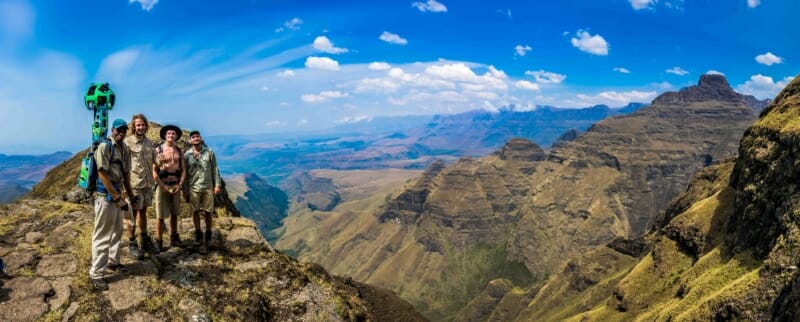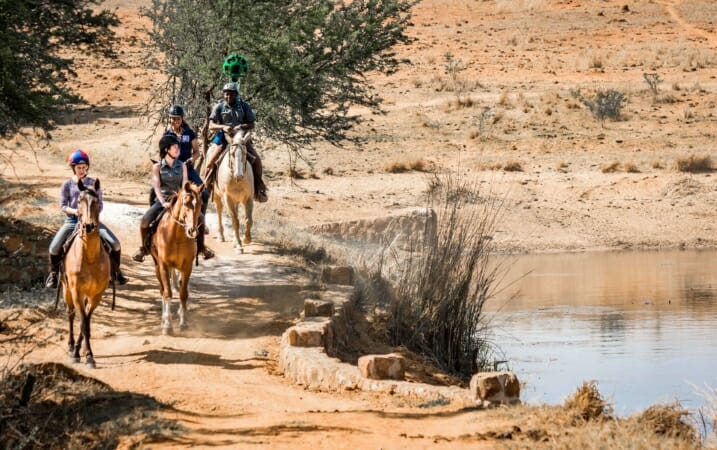Google Street View Expands to South African National Parks
One of the reasons we love technology is its ability to revolutionise the travel experience. And that goes for every step of the journey, from searching for a trip to booking, checking in and all of your transport in between. Sure, there are times when we worry that technology is becoming too central, that it risks diminishing our relationship with travel, not improving it. But that's one of the reasons why we're always on the lookout for new and exciting use cases: to make sure they are applied in the best way possible.
This week an interesting application of technology from a company we all know, Google, caught our attention. One of Google's biggest, shall we say, 'accomplishments', is Street View. Google Street View is arguably one of the travel industry's earliest game changers. Maps, used and relied upon for hundreds of years, were suddenly pushed towards obsolescence. Why look at a 2D, birds-eye interpretation when you can wander around street by street and look around the real thing?
Google Street View has since become of those fundamental applications that we all take for granted. Want to know what a particular road looks like? It will just take a second. Keen to get a sense of an area from the comfort of your sofa? It only takes a click.

Taking Google Street View One Step Further
Since the dawn of Street View, it's been clear that what began as a navigation tool could quickly become an exploratory one; a way to map every single road in the world, leaving no single corner untouched or inaccessible.
That's an interesting concept and a philosophical discussion to be had, for sure. Do we want every single road and track documented? Do we want every possible path accessible with an easy internet search? On one hand, it would provide people without the means to visit a place in person a way to explore the other side of the world.
But on the other hand, there's no doubt that a Street View mapping exercise on this scale has the potential to render untouched gems anything but. Is the special-ness, that unquantifiable, intangible magic of a hidden destination, tarnished by the knowledge that you can just as easily walk around it from your bedroom in West London?
An important point to note is the fact that Google Street View is not an adequate substitute for the real thing. You don't get the smells or the sounds (although who knows, that might be included one day). You don't get the sensual immersion of actually being there. Yet.
At which point we come to an interesting project that has just come to a conclusion in South Africa. Working in tandem with Google Street View, a team of enthusiastic South Africans have mapped out all 19 of the country's National Parks.
The huge collection of 360-degree imagery of the country’s wildest areas includes 170 new trails in South Africa’s national parks and reserves and prominent tourist attractions such as Kruger National Park, Table Mountain and Cape Point.
Understandably, this was a pretty big undertaking. Here are a few statistics from the project...
- 170 new trails
- 900km trekked on foot
- 50,000 km travelled over the 12-month project duration
- 232 points of interest recorded
- 206 South African volunteers
- 9 Provinces of South Africa
- All 19 National Parks, 17 nature reserves and many other tourist attractions
- Lion, cheetah, elephant and other wildlife encountered on foot (guided by rangers)
- 6 UNESCO World Heritage Sites
- First time Google has partnered with a third-party in South Africa via the Street View Camera Loan Program
Since the epic project's completion, Google Street View users can visit some of South Africa's most iconic sights from the comfort of their living rooms. Whether it's walking in the footsteps of icon Nelson Mandela, climbing seven new trails to the top of Table Mountain, hiking the famous five-day Otter Trail, tracking cheetah on foot or walking with elephants... many things on the tourist to-do list of the nation are now open to people all over the world.
Where Virtual Reality Comes In
To showcase the launch of South Africa’s new Street View imagery, Drive South Africa has launched a microsite that gives would-be travellers a virtual experience of South Africa.
The site - South Africa in 360 - which has been inspired by a similar project showcasing the US National Parks - is an immersive VR-adventure through South Africa’s four top tourist destinations and a collection of its lesser-known gems. The site is a culmination of Street View imagery with video, photos and stories from the trail, offering viewers unique perspectives.
This is a fantastic example of how Virtual Reality can be used in the travel industry. Just imagine the pulling power that an immersive walk through a national park could have for would-be tourists. Imagine its potential for travel agents and tour operators. Photos and videos that don't do a destination justice could now be replaced and enhanced just by throwing on a pair of VR goggles.
We've written before about the possible applications of VR in the travel industry. Giving tourists a taste of the real thing is certainly the most obvious one.
Going Off-Road With Google Street View
More than 200 South African volunteers from across the country were involved in the 12-month long project, mapping out the parts of South Africa that they call home. Many were SANParks, CapeNature and KZN Ezemvelo Wildlife rangers and guides. Others were avid hikers, nature-lovers and tech enthusiasts.
“The hundreds of volunteers who helped along the way proved to be truly passionate about showing the best of South Africa through their participation in the loan program,” says Magdalena Filak, Program Manager for Google.
The project forms part of Google’s Street View Camera Loan Program, which encourages anyone to apply to borrow the 360-degree camera technology and help map the planet.
The team of volunteers was coordinated by loan program partner Drive South Africa. Andre Van Kets, outdoor enthusiast and founder of the Cape Town-based travel company, saw the potential in this technology to showcase South Africa to travellers around the globe, when applying to the program.
“The Trekker camera is a 22kg custom-made backpack fitted with 15 cameras pointing in all directions. The onboard technology plots the camera’s exact location on the trail. While recording, the camera takes a 360-degree photo every two seconds. It’s basically the off-road equivalent of Google’s Street View cars,” says Van Kets.
“For the first time, travellers and wildlife lovers from across the globe, can explore the full spectrum of South Africa’s diverse wilderness areas on Google Maps and Street View,” he added.

Travel is About Sharing
As mentioned in the introduction to this article and in recent pieces, the travel experience is fragile and unique. That means it can easily be ruined or diminished by the addition of unnecessary tech. Everyone in the travel industry should be seeking to preserve that special experience, not spoil it with gimmicks.
That's why we work so diligently on our marketplace software: we want to improve the experience of travellers all over the world by building platforms that serve them better. Part of that process is sharing. In the case of Travelshift software, our marketplaces are a place where tourism information and expertise is willingly shared with the public through community-driven content. That's how our marketplaces are discovered and its a big part of the reason that people keep coming back.
That approach explains why we have been inspired by the way that Google Street View and its partners in South Africa have opened up the country in new, exciting ways. Now anybody in the world can witness magnificent wildlife and spectacular landscapes at the touch of a button. And once they've had a taste, you can bet they will want to come and explore the real thing. And that can only be a positive in this case.
An appreciation of the natural world is a necessary step toward admitting that it's our shared responsibility to protect it, after all.